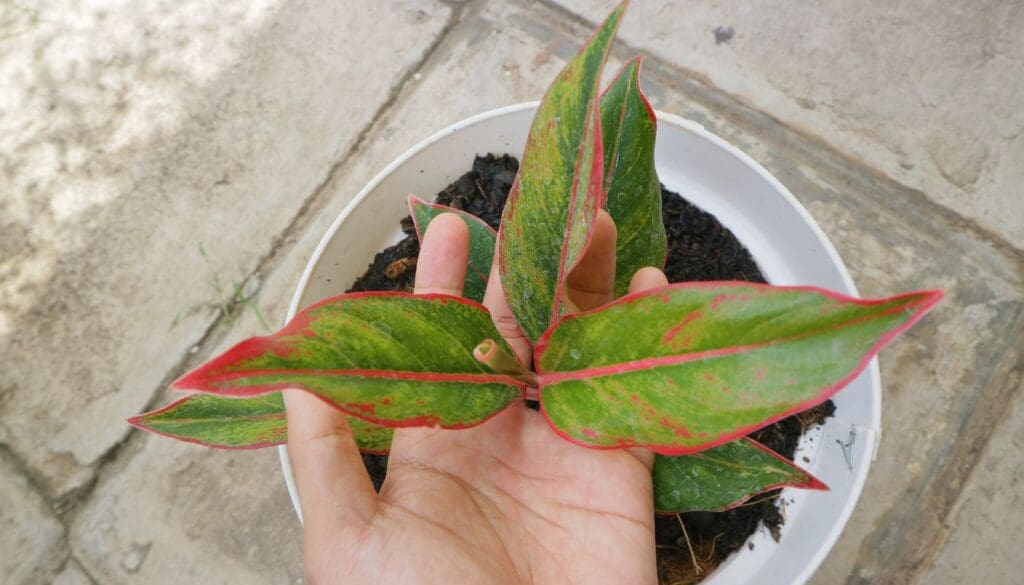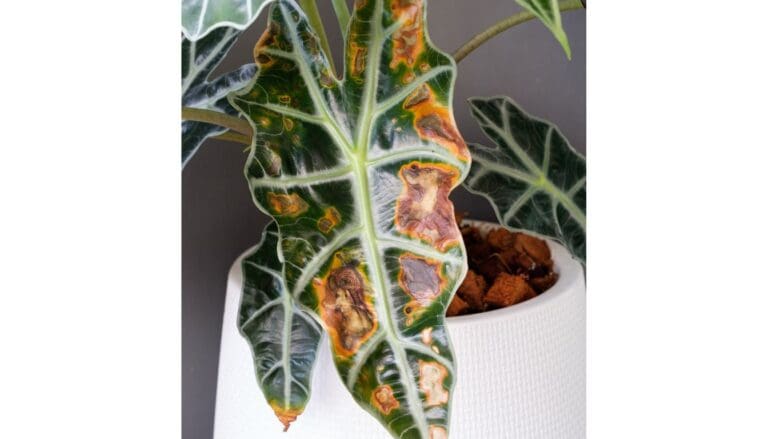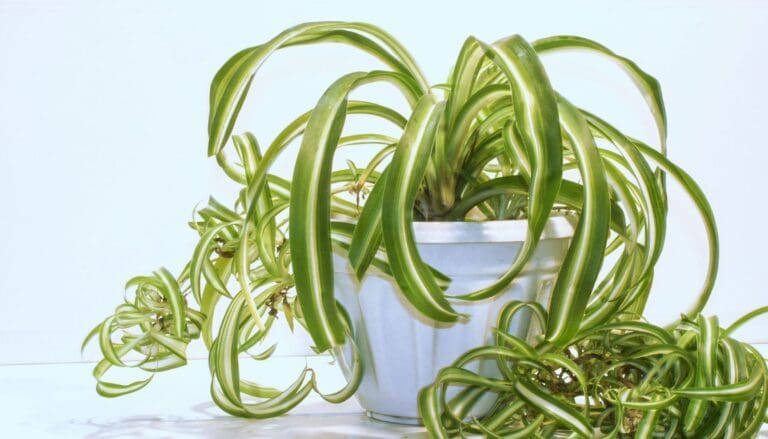How Cold Can Chinese Evergreens Tolerate? (Aglaonema Cold Tolerance)
Chinese Evergreen, also called Aglaonema, is a popular houseplant with unique and appealing leaves. Though they are hardy plants, they won’t tolerate freezing temperatures and need proper protection from the cold winters.
In this article we will discuss How cold can chinese evergreens tolerate and how can we protect them from cold.
Chinese evergreen can tolerate temperatures up to 50-55°F without cold injury. But if the temperature drops below 50°F, the leaves will turn yellow, brown, or droop. If you live in a cold region, you must maintain the temperature above 55°F and protect the plant from cold drafts.
Chinese evergreen grows ideally in a temperature ranging from 68-77°F.
If you are unaware of Aglaonema’s cold tolerance, this article will help you know its ideal temperature requirements. We will also share some winter care tips for protecting the Chinese Evergreen from low temperatures.

Please note: Simplify Plants is reader-supported. Some links in the post are affiliate links and I get a commission from purchases made through links in the post.
Will Chinese Evergreen tolerate cold?
Chinese Evergreens are lovely houseplants bearing different colors and patterned leaves. They are hardy plants that can endure cold temperatures up to 50°F.
However, some Aglaonemas can endure temperatures lower than this and won’t show any signs of damage.
If your region doesn’t receive such low temperatures, you can shift them outside to let them receive the winter morning sun. This will help them perform adequate photosynthesis.
But, if your region receives temperatures below 50°F in winters, you cannot shift them. You have to make sure they don’t get injured by cold drafts.
Some varieties can tolerate low temperatures. You can own those varieties if you want.
UF Research center proved that Emerald Star, Stars, and Jewel of India are the three varieties of Chinese Evergreen that did not show any damage when exposed to temperatures around 35-45°F.
Varieties like Maria, Green Lady, Black Lance, Silver Frost, Moonshine, and many others did not show signs of injury at 55°F. But in 35-45°F, they had extreme damages.
How cold is too cold for the Chinese Evergreen?
As I mentioned in the previous point, Chinese evergreens will tolerate a cold of 55°F. Temperature dropping below this range will turn out to be too cold for the Aglaonemas.
This temperature tolerance makes them ideal for room temperatures. A temperature below 50°F can make the plant too cold.
The three specific varieties, Emerald Star, Stars, and Jewel of India, can get the cold of about 35 to 45°F. They did not get any cold injury when exposed to freezing temperatures for constant 10 days.
So, if your region is cold most of the time, you can keep these varieties. 35 to 45°F cold is the minimal range they would tolerate.
The Research I mentioned in the previous point has shared some results while exposing the Chinese evergreens to cold temperatures at different degrees.
In 45°F, Silver Frost, Green Lady, Maria, Black Lance, Manila Pride, and Moonshine showed 4% to 15% damages. Green Majesty, Royal Queen, and Silver Queen showed damage signs of around 17% to 40%. In 35°F, most of these showed 20% to 80% of damage results.
Some varieties might be injured even at 55°F. Green Majesty, Royal Queen, Silver Queen, and Manila Pride are some varieties that can show damage results between 2% to 30%.
The UF research even encountered that the younger leaves of the Chinese evergreen could resist more cold temperature than the older leaves.
Signs of cold injury in Chinese Evergreen

The Chinese Evergreen is known to prosper at temperatures ranging from 68 to 77°F, making them ideal houseplants. One good thing is that they can tolerate a temperature of about 55°F.
However, some exceptions can get hurt even at 55°F. Even if they handle 50°F, that won’t be for long.
Eventually, most Chinese evergreens will show signs of damage at one point. Exposing them to such cold temperatures will have a very negative effect on their health. Some probable signs of cold injury are:
- Dark patches on the leaves
- Yellow leaves
- Brown foliage
- Droopy and limping leaves
- Curly leaves
Remember that these plants reduce their growth or remain dormant in winters.
So, when the above damage signs are not visible in the plant but slowed or stopped its growth, that is not a sign of damage. It is their natural process of resting.
What is the best temperature for Chinese Evergreen?
Chinese Evergreen would love to grow at a temperature ranging between 68-77°F. Temperature below or above this level can damage the plant, causing them to droop, limp, turn yellow, and die at extreme levels.
A room temperature indoors is where they will receive their best temperature.
Chinese evergreens will tolerate poor light, dry air, and drought, but not cold. Though some can tolerate cold, the below-the-belt temperature will harm them too much.
If the temperature around them is low, you have to fix it. Mulching the top surface of the soil will save the roots from cold injury. You can also manage the humidity level around them.
You might have the habit of keeping houseplants outside. But, in winters, you should not do it because they will not enjoy the chilling winds outside.
Some people take the Chinese evergreen outside to give the morning winter sun, which is indirect and perfect for these plants. But it shouldn’t last longer than 3 to 4 hours.
This can help them get a little warmth. But leaving the plant outside for longer durations will cause cold injury.
You can provide the ideal temperature by checking the temperature around them. Select a location and check the temperature. If it is perfect for the plant, place it there.
Even if they are not getting their best temperature, they will survive the room temperature.
When does Chinese Evergreen get cold?

The outside low temperatures in your region are not the only way Chinese Evergreen receives cold. Another is when you keep them in an air-conditioned room for too long or too close to the device.
You need to protect them from such situations if you want your plant to survive long term.
The leaves that get affected because of cold injury will not revive back. So, remove them. This will save energy, and the plant can concentrate more on reviving back from cold injury.
Let’s learn the two common conditions where these plants get exposed to cold temperatures and how to protect them:
Your region has freezing winters.
Cold regions are the most responsible for cold injury. If your region receives chilling winter and it’s time for their arrival, you should take precautions. Reduce watering in winters.
You can mulch the soil to keep the soil temperature warm. This will stop the cold from reaching the roots.
If your plant gets exposed to chills by mistake, relocate them to a warm location inside.
You can shift them outside in the morning for a few hours to let them have the morning sun. It will be indirect and mild, won’t cause any sunburns. It can help to warm the plant.
You have placed the plant close to fans and air conditioners.
Some people keep their Chinese evergreen in an air-conditioned room. But you should not keep the plant too close to the device. The cold and dry air can make the leaves curl, droop and turn yellow and brown.
During too hot weather, keeping it in an air-conditioned room is fine. But when the weather becomes normal, you should bring it away from that room.
Keeping the plants in an air-conditioned room for a long time causes difficulty in smooth movement and absorption of water and nutrients. It also creates cold and dry air around.
Even if these tropical plants survive dry air, they won’t like it for prolonged periods.
If you want to cool the plant down in scorching summers, you can keep it in that cold room but only for a few hours. After that, bring it back to its location.
Do not place it too close to air conditioners or under direct fans.
Care tips for Chinese Evergreen during winters
Proper light, little watering, sound drainage, distance from cold vents and open windows, and ideal humidity will keep the Chinese evergreen healthy throughout winter.
You need to pay attention to these during winters. Only then can you save them from cold injury and other injuries.
Light

You must never expose Chinese evergreen plants to direct sunlight, whether it’s winter or summer. They will thrive if they get an ample amount of indirect light.
You can shift the plant near a south or east-facing window to let it have the bright morning sun of winter for 4 to 5 hours. After that, bring it back inside.
Do this every 10 to 15 days. This can give them enough light and even warmth from the sun to protect them from cold. It can help recover cold injuries if any.
Proper light will help photosynthesis keep going in the leaves.
Also read: How Much Light Does A Chinese Evergreen Need? (Light Requirements)
Water
During the winters, the Chinese Evergreen remains dormant. So, it will not utilize the water like in the summer. You don’t need to water it frequently. It can damage the roots and the plant.
Water it only once every 1-2 weeks. The best way to avoid overwatering, especially during winters, is by checking the moisture level. The plant will not need watering unless the top 1 to 2 inches of soil dries out.
When you poke a finger inside the soil and wet soil sticks to your finger, the plant probably doesn’t need water.
If the plant ever faces overwatering in winters, stop watering and shift it to a sunny spot for some hours to let the soil dry.
Also read: How Much Water Does A Chinese Evergreen Need? (How Often+Summer & Winter)
Drainage
Make sure that after watering, the excess water drains out. Stagnant water will damage the roots, make them cold in the winters and cause cold injury.
Use a terra-cotta pot. It is known to wick away moisture quickly. It will save your plant from overwatering. Also, use a soil medium that supports good drainage.
Humidity

As Chinese evergreens are tropical plants, they will need humidity. In the winters, the surrounding air becomes too dry. Proper humidity can provide moisture to the plant.
Indeed, they don’t need watering. But the moisture level should be intact.
Install a humidifier in your room. It will mimic the exact humidity like the plant’s native land. Other ways include pebble trays at the bottom of the pot and plant grouping.
Keep away from Air-conditioned rooms and windows.
You can keep the plant in air-conditioned rooms in the summers. But that should not be for a long time. Don’t keep it in an AC room in winter.
If there is chilling wind outside, you should keep the plant a few feet away from the window.
Also read: Should I Mist My Chinese Evergreen? (+Humidity Guide)
Compost fertilizer
During the winters, Chinese Evergreen remains dormant. Along with water, it will also not need fertilizing, especially the chemical ones.
Because it is resting, it won’t utilize any nutrients you provide.
However, you can add a minimal amount of vermicompost. This will keep the plant healthy. You can also add 2 to 3 grams of neem cake or seaweed only during December.
Again start regular fertilizing in February when spring comes.
Also read: Does Chinese Evergreen Plant Needs Fertilizer? (How Often+Best Fertilizer)
Keep the plant away from the cold drafts
This is one of the critical care tips you must follow in winter. You might have kept the Chinese evergreen in an open space to let it have the morning sun. But before doing it, you must ensure that there are no cold drafts blowing outside.
Bring them inside after 4 to 5 hours. Keep the leaves clean for proper photosynthesis.
Don’t re-pot or propagate in winters

Re-potting in winters can lead to transplant shock. Because the plant remains dormant, it will not heal quickly. The growing season will help recover the shock faster than the winter season. So, if you want to re-pot it, wait.
The same reason applies to propagation. You will not find good results because of their dormancy. Propagate during the spring or summer, when they grow energetically.
If you can re-pot without disturbing the roots, you can re-pot it in winter.
You should be careful while doing it. But if your re-potting requires root disturbance, it is better to wait for spring.
Add mulch
Adding a 1-inch layer of mulch will help control the soil temperature by keeping it warm. This will stop the cold temperatures from reaching the roots. Add dried-out leaves and barks on the surface of the soil.
If there has been any injury, this mulch will help recover it by keeping it warm and preventing further injuries.
Final thoughts

Following the winter care tips properly will save the Chinese Evergreens from injury and prevent further injuries.
Let them have indirect sunlight, water only when needed, maintain humidity, and don’t expose them to air conditioners or outside chilling weather.
Always protect them from the cold by keeping them in a room temperature and a warm location. Apply mulch to the soil to control the soil temperature. That is all you need to do to take care of the plant in winter.
If your region receives mild cold in winters, you don’t have to worry much about these plants. They will tolerate mild cold. However, if the leaves of your Chinese Evergreen have got damage of over 40 to 50%, there is little hope left for the plant’s recovery.
Reference: Wikipedia, Nasa clean air study, Missouri Botanical Garden, The University of Kansas, NC State University.
Recommended Garden Supplies
| Product Image | Our Recommended Gardening Supplies | Check Offers! |
|---|---|---|
Top Top
Top
Top
Top
Top
Top
Top
Top | rePotme Houseplant and Tropical Classic Potting Soil Mix | Check Offer On Amazon |
 Top
Top
Top
Top
Top
Top
Top
Top | Espoma Organic Indoor Plant Food | Check Offer On Amazon |
 Top
Top
Top
Top
Top
Top
Top
Top | GooingTop LED Grow Light 6000K Full Spectrum Clip Plant Growing Lamp | Check Offer On Amazon |
 Top
Top
Top
Top
Top
Top
Top
Top | Soil Moisture Meter | Check Offer On Amazon |
 Top
Top
Top
Top
Top
Top
Top
Top | Govee Hygrometer Thermometer, Bluetooth Enabled! | Check Offer On Amazon |
 Top
Top | LEVOIT Humidifiers for Large Room(Best For Plants) | Check Offer On Amazon |
 Top
Top
Top
Top
Top
Top
Top
Top | Upgraded DIY Automatic Drip Irrigation Kit, 15 Potted Houseplants Support | Check Offer On Amazon |
 Top
Top
Top
Top
Top
Top
Top
Top | Stainless Steel Heavy Duty Gardening Tool Set | Check Offer On Amazon |
 Top
Top
Top
Top
Top
Top
Top
Top | Bonide Insecticidal Soap | Check Offer On Amazon |
 Top
Top
Top
Top
Top
Top
Top
Top | Bonide 32 oz Spray Neem Oil for Organic Gardening | Check Offer On Amazon |
 Top
Top
Top
Top
Top
Top
Top
Top | Garden Safe Fungicide | Check Offer On Amazon |






